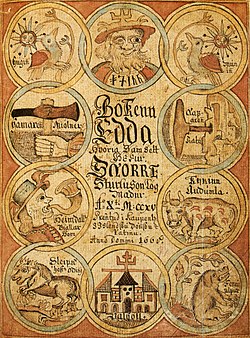| Part of a series on |
| Old Norse |
|---|
 |
| WikiProject Norse history and culture |

The Prose Edda, also known as the Younger Edda, Snorri's Edda (Icelandic: Snorra Edda) or, historically, simply as Edda, is an Old Norse textbook written in Iceland during the early 13th century. The work is often considered to have been to some extent written, or at least compiled, by the Icelandic scholar, lawspeaker, and historian Snorri Sturluson c. 1220. It is considered the fullest and most detailed source for modern knowledge of Norse mythology, the body of myths of the North Germanic peoples, and draws from a wide variety of sources, including versions of poems that survive into today in a collection known as the Poetic Edda.
The Prose Edda consists of four sections: The Prologue, a euhemerized account of the Norse gods; Gylfaginning, which provides a question and answer format that details aspects of Norse mythology (consisting of approximately 20,000 words), Skáldskaparmál, which continues this format before providing lists of kennings and heiti (approximately 50,000 words); and Háttatal, which discusses the composition of traditional skaldic poetry (approximately 20,000 words).
Dating from c. 1300 to 1600, seven manuscripts of the Prose Edda differ from one another in notable ways, which provides researchers with independent textual value for analysis. The Prose Edda appears to have functioned similarly to a contemporary textbook, with the goal of assisting Icelandic poets and readers in understanding the subtleties of alliterative verse, and to grasp the meaning behind the many kennings used in skaldic poetry.
Originally known to scholars simply as Edda, the Prose Edda gained its contemporary name in order to differentiate it from the Poetic Edda. Early scholars of the Prose Edda suspected that there once existed a collection of entire poems, a theory confirmed with the rediscovery of manuscripts of the Poetic Edda.[1]
- ^ Faulkes (1982: XI).